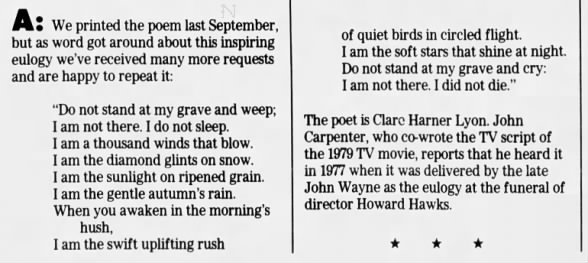 Sun, Jun 13, 1982 – 414 · The San Francisco Examiner (San Francisco, California) · Newspapers.com
Sun, Jun 13, 1982 – 414 · The San Francisco Examiner (San Francisco, California) · Newspapers.comFrom the San Francisco Examiner, June 13, 1982:
We printed the poem last September, but as word got around about this inspiring eulogy we've received many more requests and are happy to repeat it:
"Do not stand at my grave and weep;
I am not there. I do not sleep.
I am a thousand winds that blow.
I am the diamond glints on snow.
I am the sunlight on ripened grain.
I am the gentle autumn's rain.
When you awaken in the morning's hush,
I am the swift uplifting rush
of quiet birds in circled flight.
I am the soft stars that shine at night.
Do not stand at my grave and cry:
I am not there. I did not die."
The poet is Clare Harner Lyon. John Carpenter, who co-wrote the TV script of the 1979 TV movie, reports that he heard it in 1977, when it was delivered by the late John Wayne as the eulogy at the funeral of director Howard Hawks. --Paul Henniger
The poem known as "Do not stand at my grave and weep" was first printed under the title "Immortality" in a Cincinnati poetry magazine called The Gypsy, as shown in my 2018 article Clare Harner's 'Immortality' (1934). The tenth line as reprinted in the San Francisco Examiner on June 13, 1982 reads
"I am the soft stars that shine at night."
replacing
"I am the day transcending night."
in the text as originally published December 1934 in The Gypsy It seems that the later revision to "I am the soft stars that shine at night" may have been made by the author herself--possibly after her marriage to David Haines Lyon in October 1943, which would explain Henniger's use of Clare Harner's married name, Clare Harner Lyon.
In March 1980 and November 1981 Henniger had reprinted the poem without attribution.
"The identity of the poet is unknown, according to NBC. The writer of the teleplay, John Carpenter, reports that he heard it in 1977 when it was delivered by the late John Wayne at the funeral of film director Howard Hawks."
Sometime during the next six months Henniger must have learned that San Francisco resident Clare Harner Lyon wrote the poem. One year later, rival TV columnist Richard K. Shull launched the dubious and unverifiable claim for Mrs. Mary E. Frye of Baltimore as the admirably unpretentious author of "Do not stand at my grave and weep." Shull's appealing 1983 tale was influentially amplified by Kelly Ryan in a dramatic episode of the Canadian radio program "Ideas" titled A Poetic Journey, first broadcast on CBC in May 2000.
Paul Henniger's obituary from the Los Angeles Times, May 21, 1999:
Paul Henniger; Former L.A. Times TV Writer
Paul Henniger, 78, former television writer for Los Angeles Times Syndicate and The Times. Born in San Francisco, Henniger moved to Los Angeles in 1946. He worked for The Times’ sister paper The Mirror from 1948 until it folded in 1961 and then for The Times in its television news section until his retirement in 1994. For many years, Henniger helped create the newspaper’s logs of television listings and wrote a weekly column about sport programs on television. Throughout his career, Henniger also wrote a television column and numerous features for the Times syndicate, which marketed the articles to newspapers throughout the country. On May 9 in Encino of pneumonia.
https://www.latimes.com/archives/la-xpm-1999-may-21-me-39445-story.html






